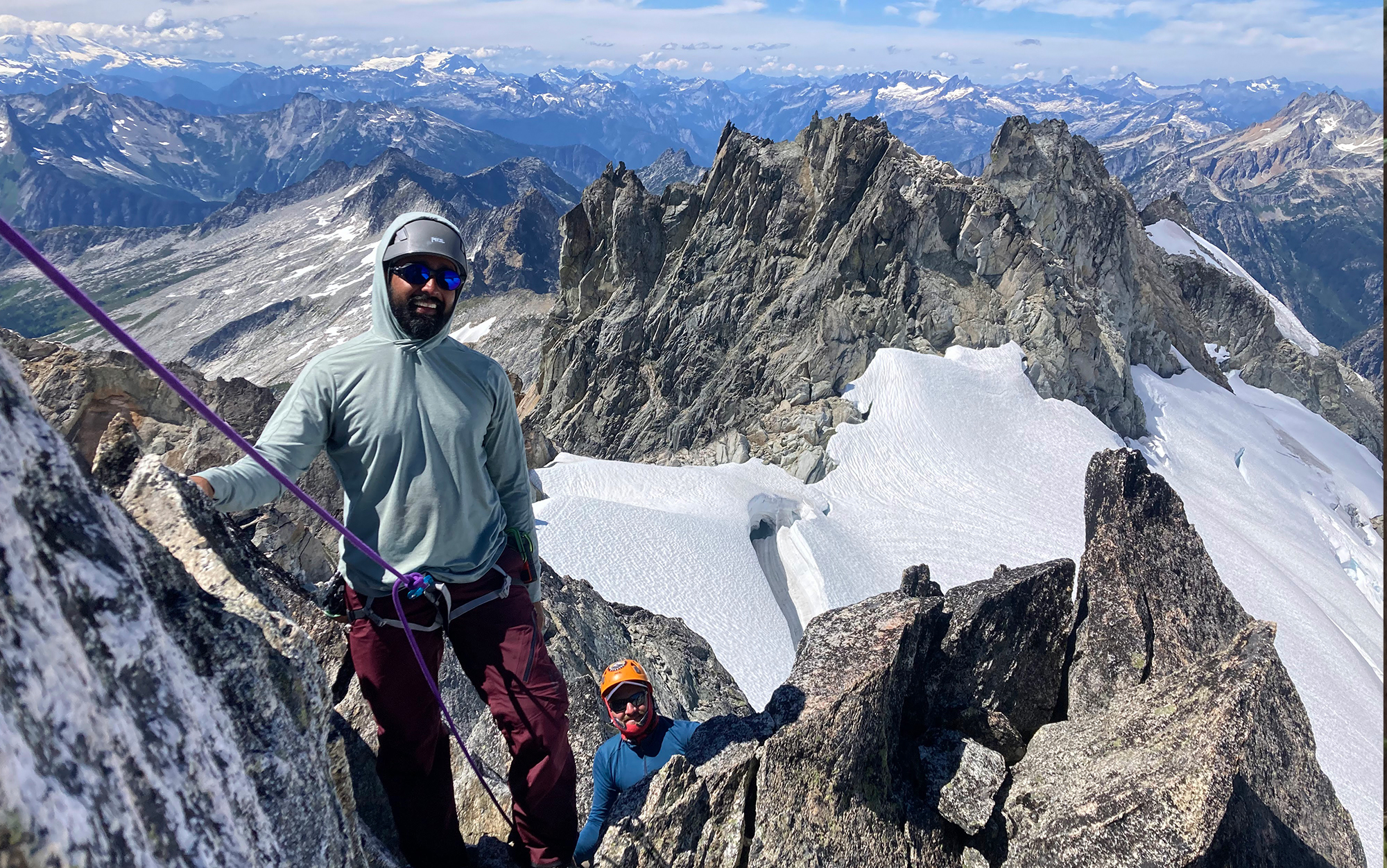We may earn revenue from the products available on this page and participate in affiliate programs. Learn More ›
If you were leafing through climbing magazines in the 90’s and early aughts you might have thought that helmets weren’t a thing in climbing. The epic photos of climbers posing on the side of cliffs across climbing publications rarely featured a helmet. When climbers used to be marketed as rebel iconoclasts chasing an adrenaline high, helmets just didn’t seem to fit the image.
But with climbing being as widespread and popular as it is today, anything that promotes a safe, approachable, and inclusive picture of the sport is welcomed and we’re starting to see a lot more helmets in those full-page climbing ads. It just makes sense to protect your head when you’re taking falls and standing under cliffs while other people do the same. So I set out to test some of the latest and greatest in climbing helmets and compiled a list of favorites to keep your mom happy and your dome piece covered.
How I Tested the Best Helmets
The most important testing that climbing helmets go through is to meet the standards of the International Climbing and Mountaineering Federation (UIAA) and European Committee for Standardization (CEN) gear certifying bodies that make sure manufacturers aren’t selling us duds. I am not here to check their work or try to replicate their lab testing with a home setup. Instead, I tested these helmets by treating them like a climber might, while focusing on some of the features that set them apart.
I stuffed every helmet into a full pack, dropped the pack on the ground three times, and then sat on the pack while it was full for at least five minutes. I’ve unfortunately broken a few helmets this way in the past and I consider that standard wear and tear. I also considered the fit, amount of coverage the helmet provided on the sides, and if I could wear a buff or hat underneath it. And lastly, I factored in the look of the helmet because trying to look cool is one of the common reasons people forgo wearing a helmet, so if it makes you look rad while you’re sending, there’s no excuse to leave it behind.
Best Climbing Helmets: Reviews & Recommendations
Best Overall: Petzl Meteor
Sean McNally
See It
Pros
- Well ventilated
- Can be used for ski touring as well as climbing
- Good side protection
- Looks sleek
Cons
- Adjustment system interferes with wearing some hats
Key Features
- Weight: 8.5 ounces
- Clips for a headlamp
- CE certified as a ski touring helmet
Petzl’s Meteor helmet has been a favorite in the climbing community for over a decade and the updated version continues to build on its previous popularity. This helmet strikes a perfect balance between everyday workhorse and lightweight performance piece. I didn’t feel like it was too delicate when stuffing it in the pack but it’s light enough that I didn’t think about it much while wearing it all day in the mountains or at the crag.

Sean McNally
I appreciate the large vents in the helmet to provide air flow while still maintaining a good amount of coverage on the side of the head. If that wasn’t a hard enough needle to thread, the helmet looks sleek and stylish. Who knew safe choices could look so cool?
The only trouble I had with this helmet was the plastic adjustment system in the back. The rigidity didn’t feel very comfortable with some hats underneath it so I had to think about my headwear choices. I found that the helmet worked best with a buff or hat made of thin and soft material to avoid creating pressure points.
As a bonus, this helmet is CE certified for ski touring as well — making it a true all-around mountain performer. If you’re a climbing enthusiast that likes to dabble in all the disciplines, look no further than the Meteor as your quiver killer because this helmet will fit right in wherever you take it.
Best Lightweight: Black Diamond Vapor

Sean McNally
See It
Pros
- Ultralight
- Well ventilated
- Looks super cool
Cons
- Expensive
- Durability is a concern
Key Features
- Weight: 5.5 ounces
- Clips for a headlamp
When you wear the Black Diamond Vapor, you better buckle the chin strap so it doesn’t float away. The Vapor feels so light that it’s easy to forget you’re even wearing a helmet when you’re climbing. I was also impressed by how roomy and comfortable it was during all day sessions. Getting a bulky hat to fit underneath this helmet was no problem with the soft cord fit adjustment system. The Vapor also provided the best ventilation from any other helmet and doesn’t skimp on protecting the side of the head to save weight — a common concern for me when considering ultralight helmets. Yes, the top of the head is the most likely place to get dinged with a rock, but it’s not impossible to smash the side of your head in a fall either.

Sean McNally
I was a little nervous when it came to stuffing this helmet into a pack and tossing it around. I’ve broken a couple of the previous versions of this helmet after being similarly rough with them so I was pleasantly surprised to see that this version didn’t crack. Most gear that is billed as ultralight is going to lack some durability though, and with this being a very expensive helmet, I might reserve it for more special occasions. But make no mistake, if you’re looking for a helmet to use during fast and light alpine blitzes or the send burn of your project, the Black Diamond Vapor is not going to weigh you down.
Best Loaner: Black Diamond Half Dome

Sean McNally
See It
Pros
- Lasts forever
- Easy to use and fit for beginners
- Cheap
Cons
- Heavy
- Other helmets look cooler
Key Features
- Weight: 12.3 ounces
- Clips for a headlamp
- Dial adjustment system
- Full plastic shell
If you like climbing with a helmet and you like climbing with other people who wear helmets, it’s good to have a burly one you can loan out. You might want to climb with someone who’s new to the sport or someone who just doesn’t own a helmet. It makes it a lot easier to insist on safety if you can just hand them a helmet out of the back of your car. The Black Diamond Half Dome is the perfect helmet for this purpose.
The Half Dome has a full plastic shell that helps it stand up to any abuse. This means you don’t have to worry about how someone is going to treat it when you loan it out. This helmet will be fine stuffed into a pack, dropped, sat on, or squished. I once dropped one off the top of a 75-foot cliff and it was completely fine when I retrieved it. This toughness is what makes helmets like the Half Dome a favorite of guide services and youth climbing programs in their rental fleets.
I also appreciate the dial adjustment system in the back as it is more intuitive for newer climbers to use resulting in a higher likelihood that they’ll wear the helmet properly. This bulky system doesn’t agree with thicker hats though, so softer material feels better underneath it. The sides of the head stay protected while donning this helmet but the weight and burly construction means you’ll feel like you’re wearing a helmet all day.
Lastly, you’ll be sacrificing style for function with the Half Dome. I think that safety always looks cool, but with all the flashy looking helmets that are out on the market today, I don’t think you’ll be turning any heads in this one.
Read Next: Best Approach Shoes of 2024, Trail and Crag Tested
How to Choose the Best Climbing Helmet

Sean McNally
There are a ton of helmets in general out on the market today. Climbing is far from the only sport that requires head protection. I’ve seen people at the crag with their bike helmets on and I’m sure the reasoning was, “one helmet’s as good as any other.” So to clear all this up, here are some things to consider when choosing a helmet.
Certification
Look to make sure your helmet is UIAA and CE certified. There are some other certifying bodies out there but those two are the main ones testing products to make sure they are fit for climbing. Every major climbing brand I know of gets their gear certified so if you’re buying a climbing helmet from a reputable climbing brand, chances are it’s been tested and certified. Other helmets designed for different sports have not been tested to these standards, so they are not acceptable stand-ins.
Also be wary of generic climbing gear sold cheaply claiming, “Made to the same specifications as ______ in the same factory.” The claim of being made in the same factory might be true, but the cost savings often come from foregoing the certification and testing process.
Durability
Match your helmet purchase to how you are going to use it. I tend to put some wear on my gear when I’m climbing so I often opt for more durable products. That’s not everyone though. One of my good friends used the same Vapor helmet over the 3 years it took me to crack two of them. He would delicately pack it away and be careful not to knock his pack around too much while it was in there.
Obviously he got some good life out of it, but if you plan to thrash and abuse your helmet, you may want to deal with the extra weight to make sure it lasts. So be really honest with yourself about how you treat your gear and make your decisions based on that.
Bright Colors
This isn’t just because you want it to match your outfits. I think it’s nice to have a brightly colored helmet so that you’re easily visible to the rest of your climbing party and in case of a rescue attempt. Obviously, we don’t ever plan to be rescued. but things happen out there. It makes it a whole lot easier for the good people who put their lives in danger to help in an emergency if they can spot you quickly. So even if you fancy yourself a climbing ninja and sport all black clothing, consider mixing it up and opting for a bright helmet.
Final Thoughts on the Best Climbing Helmets
Your climbing ability stems from your head, so if you want to climb hard and smart, protect your noodle. These days helmets are comfortable, light, breezy, and cool looking so there really isn’t an excuse to climb without one. Find yourself a helmet you like and make it an everyday part of your climbing kit, even if a camera comes out.
Read the full article here




